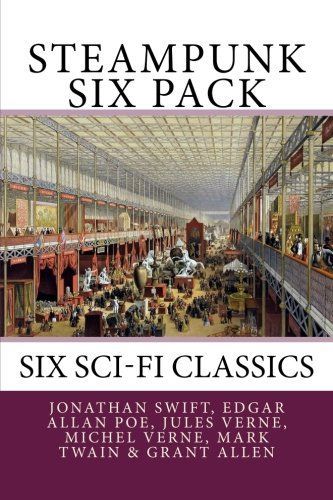
Steampunk Six Pack
"The future isn't what it used to be." The term steampunk describes the use of Victorian (steam-powered) technology in a futuristic setting. The aesthetic appears in contemporary imaginary fiction to suggest what might have been, extrapolating nineteenth-century ideas into far-flung alternative futures. But when the genre first appeared there was nothing nostalgic about the visions of where technology was taking humanity, as can be seen in the six classic steampunk titles in Steampunk Six Pack. Gulliver's Travels Part IV: A Voyage to the Country of the Houyhnhnms by Jonathan Swift Gulliver's visit to the land of the Houyhnhnms is a nightmarish voyage into a futuristic world where Nature has perfected itself and talking horses rule. One of the earliest examples of speculative futurism, Swift's imaginative canvas anticipates the more overt steampunk stories to come a century later. The story gave us the word yahoo, a derogatory term used by the equine aristocracy to describe humans. The Unparalleled Adventures Of One Hans Pfaall by Edgar Allan Poe While not busy inventing the detective genre, Edgar Allan Poe quietly kick-started the science fiction adventure craze with this speculative tale of a man who voyages to the moon in a hot-air balloon. It was first published in 1835 -- almost four decades before Verne's Around The World In Eighty Days appeared in 1872. From the Earth to the Moon by Jules Verne Verne's vision of the future here and in his other work presented in this collection, In The Year 2889 (written with son Michel Verne) is a key visual component of the steampunk aesthetic. It is hard to imagine the genre today without the dirigibles, deep-earth diggers, submersibles and other avant garde machinery that features so prominently in Verne's universe. Published in 1865, From the Earth to the Moon is almost clairvoyant in its anticipation of the first manned moon expedition 104 years later. Verne's three-man, aluminum-built spacecraft is launched from Florida by a cannon named Columbiad! The British Barbarians by Grant Allen First published in 1895, the same year as The Time Machine, this fin de siècle sci-fi is about a time traveler from the 25th century who comes back to study the 'barbarians' of the Victorian Age. From 'The London Times' of 1904 by Mark Twain First published in The Man That Corrupted Hadleyburg and Other Stories and Sketches in 1900, this science fiction sketch of Twain's is notable for its anticipation of the Internet. The story concerns an American army officer wrongfully arrested for murdering the inventor of the 'telelectroscope.' While awaiting execution, the condemned officer is allowed to use the invention. The narrator observes him as he sits on death row and surfs around the world: "...day by day, and night by night, he called up one corner of the globe after another, and looked upon its life, and studied its strange sights, and spoke with its people, and realized that by grace of this marvelous instrument he was almost as free as the birds of the air, although a prisoner under locks and bars. He seldom spoke, and I never interrupted him when he was absorbed in this amusement." Steampunk Six Pack is a retro-futurist lover's menagerie of human horses, rocket-ships to the moon, time machines and even the Internet. It's all here, in six classic steampunks from 1726-1900. "It's that déjà vu feeling all over again."
Reviews
Patricia Santos@patriciasjs
Janna@janna